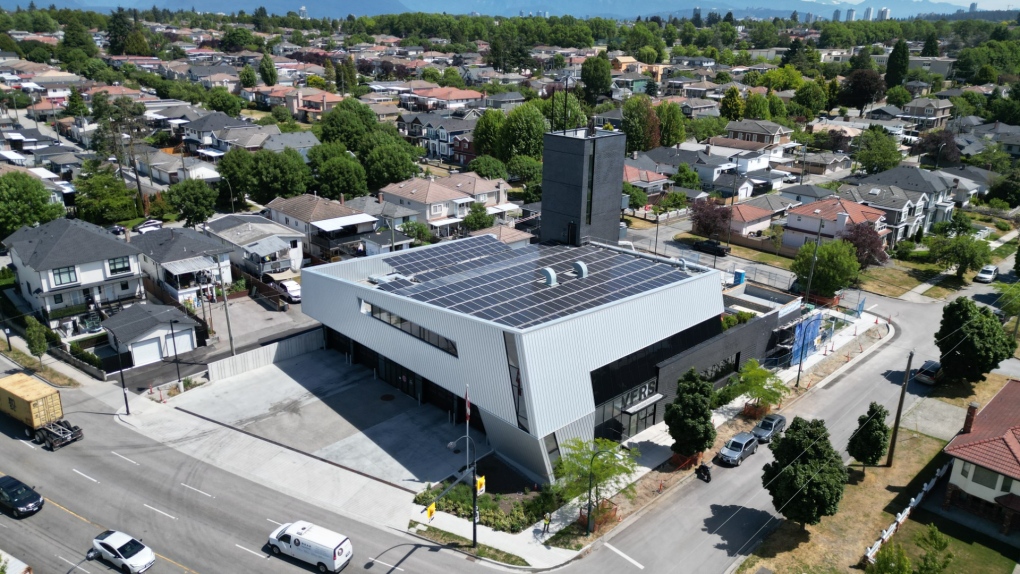Thousands of kilograms of CO2 went into building Vancouver's 'carbon-zero' fire hall
 Vancouver's new Firehall 17 is seen in this photo provided by the City of Vancouver.
Vancouver's new Firehall 17 is seen in this photo provided by the City of Vancouver.
The City of Vancouver says Canada's first "carbon-zero" fire hall will reduce operational emissions by 99.7 per cent compared to its predecessor, but there was still a significant amount of carbon emitted to construct the facility.
In fact, the city estimates it will take approximately seven years for the reduction in greenhouse gas emissions from operating the new Fire Hall 17 to offset the amount emitted building it.
The city referred CTV News to a case study it published in September 2020, while the building was under construction.
The study calculated the building's "embodied carbon emissions" as 778,000 kilograms of carbon dioxide equivalent, or about 424 kilograms per square metre.
"This makes up 97 per cent of the building’s total life cycle GHG emissions," the document reads. "Additionally, more than 90 per cent of the embodied carbon is released before the building starts its operation. Therefore, future zero-carbon buildings must explore ways to minimize not only their operational but also their embodied carbon emissions."
Most of the new fire hall's embodied carbon emissions – about 81 per cent, according to the document – are associated with the "product," meaning the materials used for the construction. Another nine per cent come from the construction process and the remaining 10 per cent from the building's anticipated 60 years of operation and emissions from its "end of life."
These calculations don't include the emissions associated with tearing down the old fire hall, but the city said that total is "expected to be low since approximately 91 per cent of the demolition waste was diverted from landfill."
Continuing to operate the old building would have been more carbon-intensive over the long term and, according to the city, was not an option.
"Fire Hall 17 was in need of replacement as the building no longer met the structural, operational or space needs," the city said in an emailed statement.
"The new fire hall is larger and is designed and built to better respond to the needs of Vancouver Fire Rescue Services today."
Located at 7070 Knight St., the new Fire Hall 17 is the second-largest Vancouver Fire Rescue Services training site, and is designed to be a post-disaster communications hub, housing equipment that could be used to keep the community connected after a major earthquake or similar catastrophe.
Still, the city said its Climate Emergency Action Plan – adopted after construction of Fire Hall 17 began – has provisions requiring lower embodied carbon emissions for future city-owned building projects.
The city's target is a 40-per-cent reduction in embodied carbon emissions – from 2019 levels – by 2030.
"We have committed to demonstrate leadership to help learn what is practical for setting embodied carbon requirements for future changes to rezoning and building bylaws," the city said. "If this requirement had been implemented prior to building the Fire Hall 17 project, the embodied carbon emissions would have been offset by operating carbon emission savings in just over four years instead of seven years."
CTVNews.ca Top Stories

DEVELOPING Jasper updates: Wildfire reaches townsite
One of two wildfires threatening Jasper National Park has reached the townsite.
Alberta calls in army to assist with wildfire situation
Alberta has called in the Canadian Armed Forces to help assist with the worsening wildfire situation in the province.
Biden explains why he ended re-election bid in Oval Office address
U.S. President Joe Biden on Wednesday delivered a solemn call to voters to defend the country's democracy as he laid out in an Oval Office address his decision to drop his bid for reelection and throw his support behind Vice President Kamala Harris.
Barrie-Innisfil MPP 'blacked-out' and crashed car into window of child care centre
Staff at a Barrie child care centre say they are frustrated by what they call a local MPP's inadequate response after a car crashed through a window in one of the toddler rooms.
Norad intercepts Russian and Chinese bombers operating together near Alaska in apparent first
The North American Aerospace Defence Command (Norad) intercepted two Russian and two Chinese bombers flying near Alaska Wednesday in what appears to be the first time the two countries have been intercepted while operating together.
2 Canadians being 'sent home immediately,' removed from Olympic team after drone incident
An analyst and an assistant coach with Canada Soccer are being removed from the Canadian Olympic Team and 'sent home immediately,' according to the Canadian Olympic Committee.
An unwelcome attendee has joined the Paris Olympic Games: COVID-19
After a handful of Australian water polo players tested positive for COVID-19 this week, questions have emerged around how the spread of the disease will be mitigated at the Summer Olympic Games in Paris.
Vacations, meals, booze: Contractor used $100K of charity's money for personal expenses, B.C. court finds
A B.C. man who was hired to help a non-profit build a food hub but instead spent the money on personal expenses – including travel, restaurants, booze and cannabis – has been ordered to pay more than $120,000 in damages.
Male, female killed, 2 others injured in 'gun battle' outside Toronto plaza: police
Two people are dead and two others suffered serious injuries following a shooting that police have described as a 'gun battle' outside a plaza in Scarborough, Ont. early Wednesday morning.






























